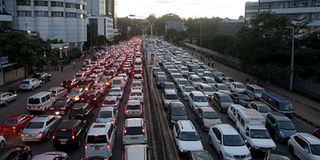To end Nairobi traffic woes, let’s put the right brains in City Hall

This image taken on December 3, 2018 shows a traffic gridlock in Nairobi. PHOTO | DENNIS ONSONGO | NATION MEDIA GROUP
What you need to know:
- We lose Sh2.1 billion a year in man hours spent swearing at one another in traffic. Add to that the reduced productivity caused by sleep deprivation, stress and anxiety.
- A park-and-ride system would work for Nairobi if we developed parking spaces away from the city and a good public transport system.
Can I ask Mike Sonko Mbuvi to give me back my vote? The unwise decision to vote for him, a hasty reaction to former Governor Evans Kidero’s dismal performance and a calculation that none of the other candidates could win, is one I regret everyday I spend in the traffic.
But it is the decision to suspend the access of matatus into the city centre, setting off one of the most painful days for commuters and motorists alike, that has left me convinced that we shouldn’t really be bothering Mr Mbuvi with the complexities of managing a modern city. His talents, such as they are, are clearly elsewhere.
It’s 7.4 kilometres from my abode to the parking at my workplace. For the morning commute, I have to budget for two-and-a-half hours to be on time for a meeting at 9am.
For a meeting earlier than that, I have to be in the traffic by 5.45am, which means I am in town by 6.15am, with loads of precious time to burn.
GRIDLOCK
I am viciously and vociferously opposed to this waste of my life. As a man whose duties extend as late as 9pm, the most painful thing in life is to waste my morning.
Many mornings, the commute is, mercifully, only an hour; but that is still a complete crawl. So, when the governor banned matatus from the CBD in some hare-brained park-and-walk-in-the-sewage stunt, the matatu folks, who are not given to deep introspection, parked in the middle of the highways to let off passengers, or pick them up, causing a massive gridlock.
Also, everyone with a car put it on the road. And then, their discipline being fragile, cracked at the first sight of congestion and tried to drive sideways and on the wrong side of the road, leading to hours spent in the fumes.
As for the police, they have no business with “personal” cars; if there are no matatus on the road, you will be hard pressed to find an officer.
CONGESTION
What was astounding was not just the governor’s ignorance about how a park-and-walk system might work; it is the extent to which he does not give a hoot about the city residents.
Walking through the sewage and the rain from Muthurwa or braving the muggers of Globe Cinema roundabout to or from the CBD is humiliating, dangerous and bad for health; nobody should inflict it on you lightly.
I shall say nothing about that blasé crack that most city residents are unfit and needed the exercise.
Congestion is costly to the economy and the person. The impact on health — disease caused by pollution, high blood pressure, depression, fatigue — is unacceptably high.
We lose Sh2.1 billion a year in man hours spent swearing at one another in traffic. Add to that the reduced productivity caused by sleep deprivation, stress and anxiety.
And, of course, there is the millions of litres of fuel that we burn going nowhere in a hurry.
INFRASTRUCTURE
In my opinion, congestion ranks among the top problems residents of most urban centres in Kenya face. Unfortunately, the folks we have elected have no clue, capacity or real interest in it.
I spent some time researching this issue, especially in one of my favourite cities, New York, which has truly frightening traffic.
It is big, with 8.5 million people, millions of them on the move everyday. Queens has the longest commute of any US county and New York’s bridges and tunnels are congested from 6am-9am and 2pm-8pm. New York has an extensive, if old, transport infrastructure.
I don’t know whether sophisticated solutions, the so-called integrated mobility framework, would work for a city like Nairobi, whose biggest problem is lack of infrastructure, users do not know how to optimally utilise the network and the transport managers are, clearly, deranged.
Such a system improves the capacity of the infrastructure by coordinating their use: subway, bus, taxi, shared bikes, et cetera.
THOUGHT
A park-and-ride system would work for Nairobi if we developed parking spaces away from the city and a good public transport system: You suck commuters from private vehicles and efficiently enable them to complete their journey through a mass transit system.
Even a park-and-walk system requires secure walkways, parking spaces and effective traffic marshalling.
But we don’t even have to go there. The scarcest commodity in the management of Nairobi today, it appears, is creative thinking and a willingness to enforce.
We need congestion pricing to force us to pay through the nose for parking and for getting into the city during peak hours.
This will compel residents to plan their lives away from the busiest periods and consider using public means. Driving into the CBD is not a human right.
SOLUTIONS
Secondly, we need discipline, better driving skills and enforcement of traffic law. This can’t be done by the police or city askaris. We need Martians to rescue us.
Finally, we need to free ourselves from matatu colonialism and replace these small smokestacks with big, efficient buses and to turn, in a big way, to non-road transport.
We should have bike lanes and walkways to encourage folks to walk and ride to work. I am reasonably confident that none of this will happen with Mr Mbuvi in City Hall.
Not that I have anything against him; I am just convinced that he is the wrong guy for this kind of thing. I wish I could get back my vote.





